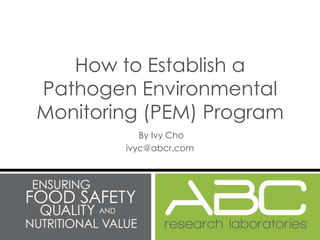
How to establish a pathogen environmental monitoring program
- 1. How to Establish a Pathogen Environmental Monitoring (PEM) Program By Ivy Cho ivyc@abcr.com
- 2. Questions to ask • What are the environmental sources of spoilage organisms? • Where is the presence of foodborne pathogens or their indicators in the environment and on the equipment? • How effective are the cleaning and sanitation practices? • How frequent should the cleaning and sanitation be practiced?
- 3. Facility environment • Pathogens can enter as raw materials, ingredients, pests, or by people. – Persist in niches and hot spots and moves through the facility by traffic flow, dust, and condensation Perfect recipe for contamination!
- 4. Microbiological concerns • Pathogens – Salmonella spp. – Listeria spp. – E. coli 0157:H7 • Indicator organisms: non- pathogenic, indicat ors for contamination – Aerobic plate count – Coliforms – E. coli
- 5. PEM zoning concept – Zone I • Zone I: direct or indirect product contact surfaces after the lethality or microbial reduction step and before the product is sealed in the primary package
- 6. PEM zoning concept – Zone II • Zone II: non- product contact sites adjacent to Zone I
- 7. PEM zoning concept – Zone III • Zone III: non- product contact sites adjacent to Zone II, areas of cross- contamination risk
- 8. PEM zoning concept – Zone IV • Zone IV: areas remote from Zone I
- 9. PEM zoning concept examples Zone I – slicers, conveyors, peelers, strip tables, utensils, work tables, racks, employee hands, pumps, hoppers, fillers Zone II – exterior of equipment, refrigeration units, framework, equipment housing Zone III – phones, air return covers, hand trucks, forklifts, walls, floors, drains Zone IV – cafeteria, locker rooms, halls, warehouse, loading dock
- 10. Sampling methods for PEM • The use of proper sampling methods is crucial for ensuring reliable and defensible data. – Surface sampling: sponges and swabs – Product residue scraping and dust samples – Water and rinse samples – Air samples
- 11. Establish your baseline • Investigational sampling is intensive to establish a baseline. – It is not uncommon to sample 25-50 target areas in each zone everyday for a month. • By determining the baseline counts, it will be established what is unacceptable and acceptable under normal operating conditions. • Move to routine sampling; rotate sites and test each site 4 times a year.
- 12. Sampling Diagram Minimum Zone Sampling site Microbiological analyses sampling Number of frequency samples I Direct product Indicator organisms Weekly Line contact site and pathogens under dependent special situations II non-product Pathogens Weekly 10-15 contact sites adjacent to Zone I III non-product Pathogens Weekly 10-15 contact sites adjacent to Zone II, areas of cross- contamination risk IV areas remote from Pathogens Monthly 5-10 Zone I
- 13. How valuable is a PEM program? • It is more dependable and concrete to monitor the environment than to depend on finished product testing only. – Can help identify and eliminate harborage niches and hot spots. – Can demonstrate food safety competence to visitors (auditors, buyers, regulators). – Verifies that sanitation, GMP’s, and pre- requisite programs are working in competence.
- 14. Related information Video instructions on how to perform environmental sampling The dos & don'ts of environmental sampling Video instructions on how to sample water & ice How to sample for laboratory water testing
- 15. Questions? For additional information, please contact us at 352.372.0436 or visit our website at abcr.com
